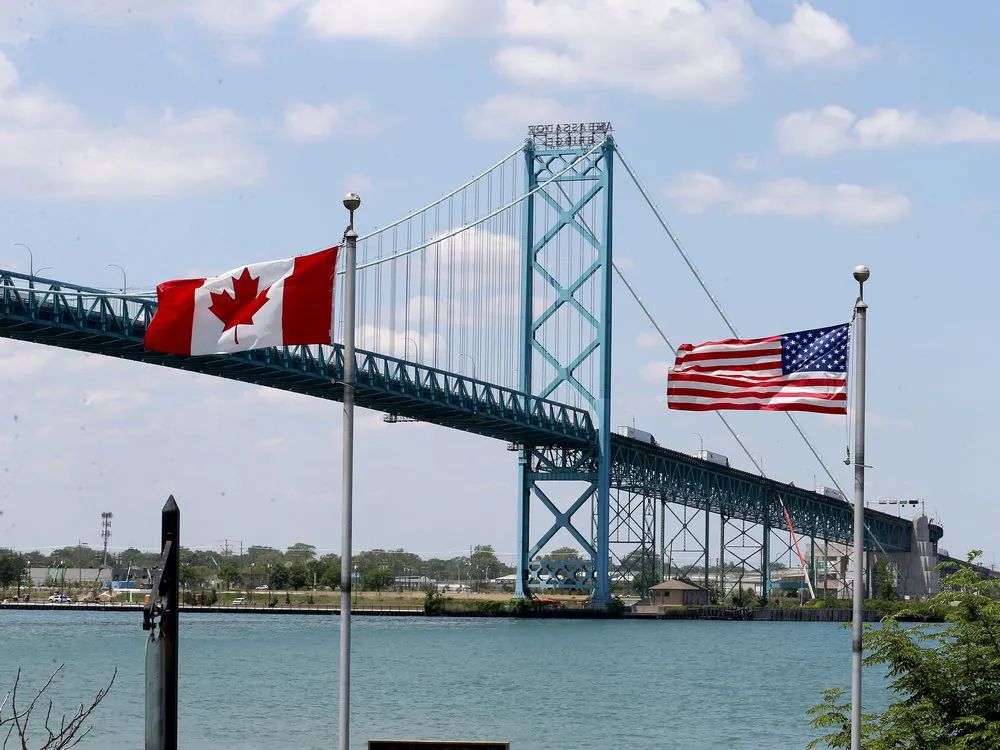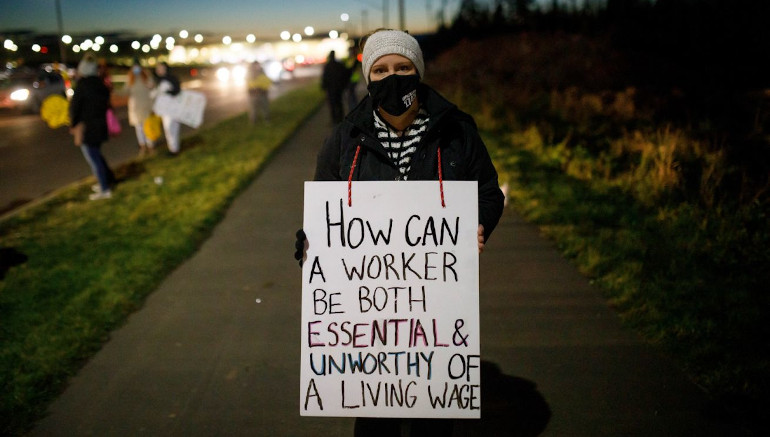Update: March 4
Trump has declared a trade war on Canada and Mexico. Workers in Canada, Mexico and the US need to draw up plans to protect jobs, livelihoods, living standards and homes.
Trump has imposed tariffs on Canada, Mexico and China. On March 4, he confirmed his long-threatened tariffs of 25 percent on all imports from Mexico and Canada, except Canada’s energy resources, which have a 10 percent tariff, and 20 percent across the board on all imports from China on top of the many already existing tariffs.
As these tariffs bite, they will devastate Canada’s and Mexico’s economy and put up prices in the US. Exports to the US account for at least 17.8 percent of Canada’s GDP and more than 2.4 million jobs directly. Canada exports 74 percent of its oil and gas production to the US and 54 percent of its auto and other transport manufacturing goods. Fishing, uranium and logging also rely heavily on US exports.
The Canadian government has proposed a range of retaliatory actions, starting with 25 percent tariffs on $30 billion of US imports on February 4 (the day Trump’s tariffs start) followed by further tariffs on $125 billion of imports in 21 days. The government is also looking at further actions such as blocking exports or US companies bidding for government contracts. These actions will boost prices in the US and hit production and jobs in Canada. There is risk that Trump will further increase tariffs in retaliation for the policies the Canadian government announced.
Several provinces have also announced actions such as blocking US alcohol sales in government stores and wholesalers, implement buy-Canadian policies and stop US companies getting government contracts.
The US economy does rely on Canada for many goods, including oil and gas, auto parts and finished vehicles, uranium and potash, wood products and some critical metals. This reliance has increased in some cases as other sources are restricting supply in response to US tariffs and sanctions. China has stopped exporting gallium, germanium and antimony (Canada produces the last two) to the United States. Russia has stopped exports of uranium to the US, while Kazakhstan is looking to shift its exports to Russia and China, rather than to the US and Europe.
US importers will pay the tariff on Canadian goods. To compensate, they can pass on the extra cost to American consumers, put pressure on Canadian exporters to lower their prices, switch to US suppliers if any exist, or some combination of the three. In both Canada and the US, bosses will try to pass the brunt of these impacts onto the working class, through higher prices for workers in the US and job losses in Canada and Mexico. The auto industry is highly integrated between Canada, Mexico and the US with parts moving back and forth multiple times before the final vehicle rolls out the gate in any country. The auto industry will face major disruptions. Workers in all three countries will face workplace slowdowns and closures, job losses and pay cuts.
A section of US business and politicians are opposed to the tariffs. The headline of The Wall Street Journal read “The Dumbest Trade War in History.” A senior leader of the US Chamber of Commerce stated “the imposition of tariffs … will only raise prices for American families.” Even some Republicans have raised criticism, with Rand Paul stating, “Tariffs are simply taxes. Taxing trade will mean less trade and higher prices.” Will these concerns cause Trump to reconsider?
Tariffs and a trade war between the US and Canada would plunge Canada’s already faltering economy into recession. While a trade war would also hurt the US economy and workers, its economy is far bigger and more able to withstand shocks, at least for a time.
However, the trade war will hit the US economy with inflation and disrupted production and supplies. The tariffs are also imposed on Mexico and the tariffs and retaliations could cause a recession in all three countries, which could drag much of the rest of the world down.
Politics in Turmoil
Trump in in the White House has upended Canadian politics. At the start of 2025, Poilievre, the head of the Conservative party, seemed set to cruise to a large majority in the upcoming election. Then Trudeau paused (prorogued) Parliament until March 24 and resigned, triggering a Liberal leadership election, with the winner to be announced on March 9.
Trump’s tariffs have complicated things for Poilievre. The two most powerful conservative provincial leaders, Doug Ford in Ontario and Danielle Smith in Alberta, have responded to the threat of tariffs by going in opposite directions. Ford talks of war while Smith talks of conciliation. Ford is open to stopping exports to the US such as electricity, oil and gas and minerals. Smith wants to keep exporting oil and gas.
Which side of this disagreement will Poilievre support? He has spoken in favour of retaliatory tariffs but so far not on cutting off exports. To be seen sitting on the fence will not present an image of decisive leadership.
He also has political problems. He has built his election strategy on attacking Trudeau and calling to “Axe the Tax.” But Trudeau has resigned, and the carbon tax is likely to follow as both the liberal leadership front runners, Carney and Freeland, have proposed to abolish it. The election is now likely to be focused on tariffs, unemployment and Trump, rather than on Trudeau and the carbon tax. Of all of Canada’s federal politicians, Poilievre is the most Trump-ish, hardly an attraction with Trump’s devastating tariffs.
Recent opinion polls show a shift back to the Liberals, not enough to save them but perhaps enough to stop Poilievre’s landslide.
Team Canada
Most Canadians are angry and there has been a wave of Canadian nationalism. An Ipsos poll before Trump announced the tariffs found 82 percent thought “Canada should retaliate.” Fans at hockey games in Ottawa, Calgary and Vancouver, and a basketball game in Toronto, booed the US national anthem on the weekend after Trump announced the tariffs.
Much has been made of a “Team Canada” approach although at the start Danielle Smith was not on board and Pierre Poilievre was missing. Belatedly, Smith and Poilievre have agreed, but still with reservations. Doug Ford has been a loud supporter. He is hoping his “Canada Is Not for Sale” theme will win him the election he called 18 months early, before Ontario’s economy goes south.
The primary cause of the US’s trade deficit is the importing of cheap heavy crude from Alberta, which is used by refineries on the Gulf of Mexico. Stopping the import of heavy crude will either mean these refineries close (as they are designed to handle heavy crude) or importing oil from Venezuela, Russia or the Middle East — all more expensive and with some political costs. Stopping imports of Canadian oil will put up gas prices in the US.
The importance of Alberta’s oil exports to the US economy and the total dependence of Alberta’s government on oil revenues explains Smith’s effort to conciliate, not block, oil exports and not be part of “Team Canada.” However, it is unlikely that her charm offensive on Trump produced lower tariffs on oil: it is the cold economic reality that the US relies on oil from Canada.
Workers need to be wary of Team Canada. It can sound beguiling for the country to unite but the country is not united. There is a fundamental class division much deeper than the clash between Smith and Ford.
Canadian bosses and Canadian workers have different class interests. The bosses do not support paying workers higher wages or paying higher taxes to provide good public services. They were united in calling for the government to end the strikes of port, rail and postal workers. Most politicians represent the class interests of the bosses, whatever fancy words they might use about working people, the middle class, etc.
However, the idea of left Canadian nationalism is likely to grow. Lana Payne, the head of Unifor, the country’s largest private-sector union, said that Trump “has enraged and united an entire nation that is ready to fight to defend every last job in this country.” Canadian bosses have not fought for every job and will not in the coming recession, rather they will try to maintain profits with higher prices, lower wages and fewer jobs.
What is Trump’s Goal?
It is difficult to understand Trump’s goals, methods and plans. Both he and US capitalists agree that Canada and Mexico are not US imperialism’s biggest rival; that is China and its allied block. Yet Trump has started his presidency with 25 percent tariffs and talk of taking over both Canada and Greenland.
Trump has claimed that the tariffs are because of the flood of fentanyl and undocumented immigrants coming into the US from Canada and Mexico. This allows him to claim it is an emergency and so ignore the long-standing trade agreements (NAFTA and UMSCA) between the three countries. It was under Trump’s first administration that UMSCA came into force in 2020. However, this is unlikely to be the main reason as it is estimated that only 1 percent of fentanyl comes from Canada, with a similar portion for undocumented immigrants.
Howard Lutnick, Trump’s nominee as Secretary of Commerce, has stated that the current tariffs are to encourage Canada and Mexico to take action on fentanyl, and further that the president is concerned about “non-tariff barriers to trade,” such as supply management of the dairy industry and provincially-regulated forest stumpage rates. He said there may be more tariffs in April to address these issues and open up Canadian markets to more US products.
The revenue from Trump’s tariffs, in effect an indirect tax on US workers, may help offset the big tax cuts Trump plans to deliver to his rich friends.
US imperialism, the dominant capitalist power since 1945, in the last decade has seen its top dog position challenged by rising Chinese imperialism and Russia’s war in eastern Europe. While the US is still the world’s largest economy and war machine, its ruling class feels threatened. Trump is seeking to re-establish US capitalism’s domination.
Trump’s ambition of one nation state, including most of North America, echoes US politics in the 19th century with the talk then of “Manifest Destiny.” John Quincy Adams wrote in 1811 that “the whole continent of North America appears to be destined by Divine Providence to be peopled by one nation.” In the 19th century US capitalism bought the Louisiana territory (most of the land drained by the Mississippi) from France. The US forced, often by war, Spain and later Mexico to cede Florida, Texas, California, Nevada, Utah, Arizona, and New Mexico and Britain to cede Washington, Oregon and Idaho. It also purchased Alaska from Russia.
No doubt a unitary capitalist state that included the US, Canada and Greenland would be the world superpower. It would dominate the Arctic Ocean, now thawing and opening for shipping and mineral extraction. It would have access to almost all of the critical minerals and have huge reserves of fossil fuels. It would have plentiful water, if the rivers of northern Canada (Yukon. Mackenzie, Coppermine and Churchill) were redirected to the southern US (first suggested in 1950s as the North American Water and Power Alliance).
Annexing Canada seems unlikely, but Trump did threaten to use “economic force” to make Canada join the US. In a long trade war, the already existing tensions between the interests of Alberta’s oil bosses and the rest of Canada’s capitalist class could grow. It is conceivable that a section of the right-wing pro-oil conservative Albertans might be tempted to end the trade war and join the US. It would provoke deep divisions in Alberta and enormous anger in the rest of Canada.
In the short term, Trump is more likely trying to bring some manufacturing back to the US from Canada and Mexico, but that will take years to build new factories. He also wants the Canadian government to increase military spending, especially in the Arctic.
There is a real risk that the announced tariffs, plus the planned ones on the European Union, will trigger a world recession. They would also give Chinese imperialism an opportunity to weaken the US-led alliance against it. Faced with a both a world recession and a strengthening of Chinese imperialism, the US ruling class may call for a change of policy.
One other motive is to say to all the world, friend or foe, this is how I treat my allies, don’t mess with me, Donald Trump, or the Great America.
Free Trade or Protection
Throughout capitalism’s history, the ruling class of different nations have switched between policies of free trade and protection (putting up barriers to trade, including tariffs). The choice of policy is not dictated by the needs of workers, rather it is predicated on what policies serve the capitalists’ drive to increase their domestic profits.
Protection increases the cost of imports, which may be manufactured goods, food or raw materials. In every case, these higher costs are eventually paid by workers in higher prices. Free trade may lower prices but lead the bosses to move production and jobs to cheaper wage economies. The North American Free Trade agreement devastated small farmers in Mexico and hit manufacturing jobs in the US and Canada.
Marxists have supported neither free trade nor protection, advocating instead a planned socialist economy.
A Workers’ Program
Trudeau, in announcing Canadian tariffs, stated, “We are all in this together,” part of the Team Canada approach. This same claim was made during COVID, but as workers discovered it was not true, as the rich got richer and the poor, poorer. Essential workers caught COVID, while the bosses stayed safe. The lessons of COVID’s inequality need to be remembered in responding to this emergency.
Unions and the NDP need to demand that workers not pay for the tariffs. They need to fight against plant closures, layoffs and loss of pay. Workers who lose their job or pay must be compensated by the government. Workers who have lost income must be protected from losing their homes or piling up rent or mortgage arrears. If the bosses try to close workplaces or move production, the workplace should be occupied with workers fighting for public ownership. Increased taxes on the corporations’ super profits should pay for supporting workers. Unions and consumer groups should monitor prices to check if corporations are gouging prices and profits. If large corporations receive government funds it should be either loans or in return for part ownership, and a guarantee of no job losses. There must be no scams as happened with the COVID Canada emergency wage subsidy program, where companies took the money and still laid off workers, while using the money to pay out dividends to shareholders.
Unions and consumer groups should monitor prices to check whether corporations, such as supermarkets, are not gouging prices and profits.
A key component of a workers’ program is an appeal for international solidarity. These tariffs —one way or another — will hit workers in Mexico, the US and Canada. Rather than fighting each other, workers’ unity to resist the tariffs, pay cuts, job losses and price hikes would be a powerful deterrent. Auto workers in all three countries should stand united against plant closures and layoffs.
Canadian unions must hold emergency meetings to discuss a workers’ response. It is not enough to rely on the goodwill of employers and politicians. In these discussions and meetings workers will bring forward many other good ideas on how to protect jobs and living standards.
The pain that the capitalist class will try to inflict on workers is yet further proof that capitalism is a diseased system that puts the profits of a few above the needs of the many.
The chaos of the world today makes it clear that a socialist transformation of society is needed to so the economy can be planned for the benefit of workers and the environment.



